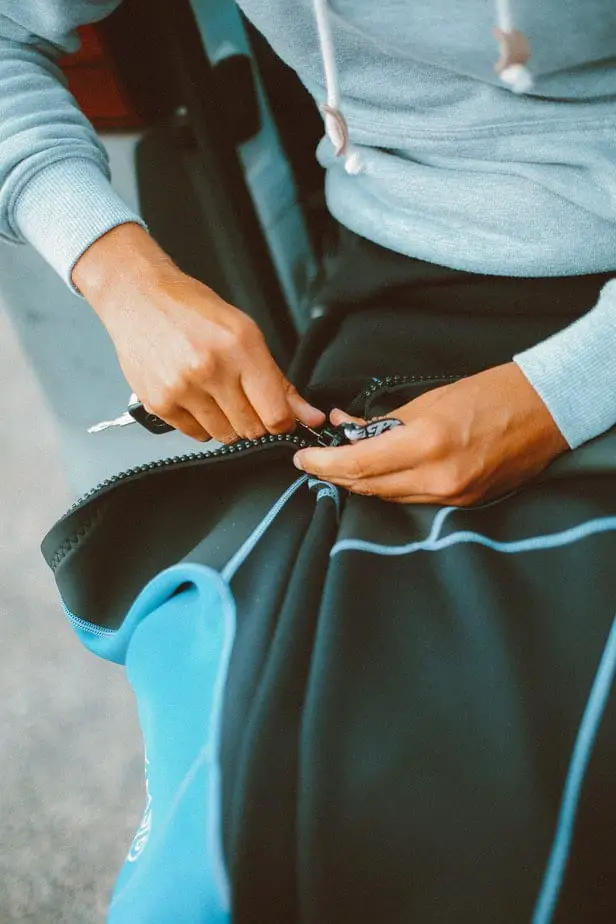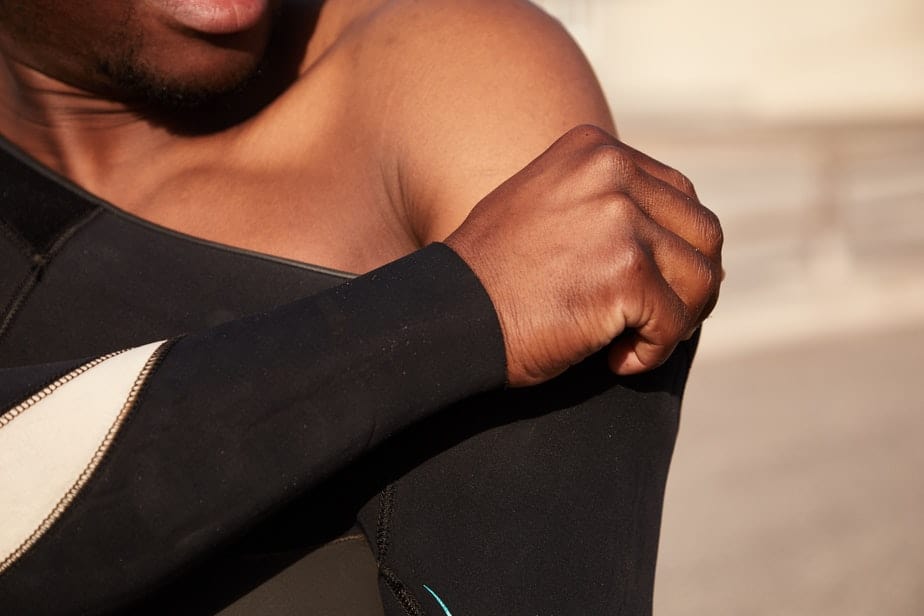Do you like rocking the “all black everything” style? Well then, you might like how most scuba diving gear looks, particularly when it comes to wetsuits. It’s hard to knock on black. It goes well with everything, it makes you look slimmer, and it gives you a serious look. But are these really the reasons why most wetsuits are black? Or are there practical, beneficial reasons for this choice?
In this article, we’re going to answer the question: why are most wetsuits black? You’ll discover that black wetsuits have many advantages, from its early manufacturing process, to its durability, to its UV protection and insulating properties and much more. Plus, black just looks really good. Let’s dive into this dark mystery.
Black wetsuits – the beginnings

Since wetsuits were first publicly available in the 50s, wetsuits have been a staple piece of equipment in many water sports because of the insulation and comfort they provide. Water is extremely good at drawing heat from the body, and people wanted to participate in their respective activity for much longer and in different environments. Wetsuits were the solution to that.
Originally designed with surfers in mind, wetsuits turned out to be so versatile they could be used in a variety of different applications, another notable one being scuba diving. Ever since it was first released in the 50s until now, wetsuits have always been black.
The original reasons were mostly due to economics, but now there are some practical and cosmetic reasons why it stayed black, and we each section below will explain this in further detail.
Early manufacturing

As we mentioned, the original reason for wetsuits being black is due to how expensive it is to dye it.
The earliest wetsuits were constructed from natural rubber. Nowadays, wetsuits are made using closed-cell neoprene, which is a synthetic waterproof material.
Neoprene is such a great material for wetsuits thanks to its insulating and buoyant properties. The neoprene sheet has gas-bubbles (closed-cells) sealed into its material during manufacturing, and a finished neoprene sheet is naturally black due to its manufacturing process.
Certainly, these wetsuits can be colored and come in interesting patterns and designs. However, adding color is an added cost and provides little to no benefit in many of the applications where a neoprene wetsuit can be used. Believe us, they really tried to make colorful wetsuits a thing, but it didn’t pan out (more details in the next section).
In modern wetsuits, the primary neoprene material is actually sandwiched between two more protective layers – the external layer adds extra tear resistance, and the internal layer makes it easier and more comfortable to don and doff. Just remember to put on the wetsuit when you (and the wetsuit) are both dry, otherwise the friction will be too high.
The external layer will typically be a durable material such as silicone rubber or nylon, whereas the internal layer will be a soft synthetic lining.
Since the wetsuit is naturally black after all of these layers are applied, a significant amount of coloring would be required to make the color show. Would you really want to spend even more money on a wetsuit than you already do? The public didn’t think so either, and that’s why it didn’t catch on.
The failure of colored wetsuits

On paper, colored wetsuits seemed like a sound idea. In the same way that one’s clothes could come in a variety of colors, and intricate designs could increase the value of a piece of clothing, why doesn’t this logic apply to wetsuits?
In fact, one could make the argument that colorful wetsuits have the benefit of increasing one’s visibility making it easier to track a diver or regroup/rescue them if they get separated/lost. Yet, black wetsuits are still the overwhelmingly dominant choice.
A basic economic principle is that if there were demand for vibrantly colored wetsuits, manufacturers would increase their production of them to cash in on that market. However, it just never took off for some reason.
Way back in the 60s, after wetsuits had been in the market for about a decade, a yellow wetsuit called the Aquafort was manufactured. It touted its high visibility as one of its major selling points. It failed to generate enough profits, so that was soon discontinued.
Pictures from the 80s show that there were indeed scuba divers wearing bright, fluorescent colors. As you’ll remember, this was the fashion for the time, and fashion is fickle. It proved nothing more than a fad, and once again, black wetsuits were the norm.
As long as the demand for colored wetsuits is low, it simply isn’t cost-efficient for manufacturers to mass produce them. Thus, they will stick to what is tried-and-true, which is just a conservative black wetsuit.
Why do black wetsuits have so much longevity? Perhaps people simply prefer the color black. We can come up with a few reasons why black is such a good color for wetsuits.
Why are black wetsuits so popular?

The color black is special, kind of like white. They are neutral colors that go with any other color. For instance, you could have a black wetsuit and a yellow regulator. The black goes perfectly fine with it. But if you had a pink wetsuit and a yellow regulator, it’d look kind of strange, don’t you think?
Black is also just a good looking color. In the fashion world, which we admit is fickle, for a time there was a style known as “all black everything” because people felt black on black just looked good. You can deviate from this by wearing mostly black but having a statement piece such as a bright colored piece of footwear or watch to make it stand out. The same can be done for scuba diving gear with a dive watch or regulator that contrasts against the black wetsuit for a cool style.
Another consideration is that wearing black makes you look taller, slimmer, and serious. For whatever reason, wearing all black gives off the impression that one is thinner, which also helps one look taller. The color black is also associated with clothing worn to solemn or formal events and gives one a more mature, refined look.
In comparison, a bright colored wetsuit can make one look like a clown or a raver or something. Whatever the case, style is highly subjective and the execution of the overall outfit also matters in fashion. There are no rules. Plus, this is scuba diving we’re talking about. Function should take precedence over form, and in the end, it’s all up to the individual. But the public has spoken, and black stays winning.
Are all wetsuits black?

No, there are still colored wetsuits available, but black is the most common color by far.
If you want to have some sort of design on your wetsuit, manufacturers also make suits with colored panels to add a little bit of pizzazz to a black wetsuit’s appearance.
There are also camouflage wetsuits that are popular with spearfishers to hide their presence from the fish they are hunting.
There are some gimmicky wetsuit designs that are designed to look like a superhero costume, an underwater tuxedo, or all manner of fun appearances.
Keep in mind that if you get a bright colored wetsuit, that its appearance may not be the same as on the surface due to the color loss that occurs at deeper depths.
First the color red is lost, then orange, yellow, and so on, until everything just looks dark blue. So if your wetsuit has a lot of reds on it and you’re diving past the point that reds are lost, then you may not look as good underwater as you might think.
What are the benefits of a black wetsuit?

In addition to being a popular choice that can go well with any other color or designs, black wetsuits actually provide some practical benefits that you might not have considered.
For instance, did you know that the color black absorbs the most energy from the sun than any other color? Conversely, white repels the most energy. The outcome is that black wetsuits provide the most warmth. They also dry faster between dives compared to one that is lightly colored.
Black wetsuits also have the same benefit as any black clothing where stains or any kind of wear and fading aren’t as noticeable. The materials wetsuits are constructed out of are generally very durable anyways, however black can mask many imperfections which gives it some longevity before you need to buy a new one.
Also, as we mentioned, a colored wetsuit might not even look like what you think it does underwater. In the case of a black wetsuit, it will still look black.
Are sharks attracted to colored wetsuits?

There are a lot of theories floating around online and also being verbally passed down by veteran scuba divers who have had their own unique experiences with sharks.
Currently, there is no clear link regarding a specific wetsuit color attracting sharks. There is intense debate about the color yellow standing out in particular to sharks, to the point that it’s even jokingly referred to as “yum yum yellow”, but it has not been shown to be demonstrably true by researchers.
We know that sharks can see color, however the theory is that sharks are noticing the contrast in colors. So if you don’t want a curious shark getting uncomfortably close to you, perhaps keep your scuba equipment all in one color.
To alleviate concerns about color, keep in mind that sharks have other senses they rely on, particularly smell. Surely you’ve heard that a shark can smell blood from around a quarter of a mile away, so perhaps your concern should be whether you’re bleeding or not. But as this video shows, even that might not be a problem.
Sharks are mostly attracted to fish blood. Humans are not their usual prey, which is why shark attacks are so rare. The belief is that whenever a shark attacks a human, it’s because they confused us for a fish. Once they realize their mistake, they swim away. Unfortunately, even a single bite can be fatal, but the point is it’s extremely unlikely to occur.
Are there advantages to wearing colored wetsuits?
Definitely, yes. The primary benefit of a colorful wetsuit is increased visibility, both at the surface and underwater.
If you get lost or separated from your group, you are more likely to be spotted if you’re wearing a colorful wetsuit. This also applies to rescuers who are trying to find you, or boats if you’re in an area with boat traffic or a boat is trying to pick you up.
Keep in mind that your wetsuit will lose colors depending on how deep you’re at, so remind your dive buddy that you might not look the same 100 ft underwater.
That aside, there aren’t any cons to wearing a colored wetsuit, unless you consider making a fashion blunder a huge mistake depending on how garish the design is. There is also the minor downside of colored wetsuits getting dirtier faster. Overall, it’s almost entirely upside.
Parting words
Now you know why most wetsuits are black. No, there isn’t any conspiracy, nor is everybody in on a joke. Black wetsuits are just the most practical from an economic standpoint, and it gets the job done. The color black also pairs well with any other color, so you can perhaps make your regulator or dive watch a statement piece by getting one that has a vibrant color.
Instead of worrying about a wetsuit’s color, why not focus instead on whether it’s able to keep you warm and comfortable in the cold water? Consider the wetsuit thickness and how easy it is to don and doff rather than if it has a cool color design.
Whatever color your wetsuit is, as long as you can stay safe and enjoy your dive, that’s the most important consideration. Plus, at deep depths you’re likely to lose most of the color anyways, so why bother? Black wetsuits are fine just the way they are, and have been around for over 70 years and counting. Black has proven itself to be iconic and it will be hard to change that.


